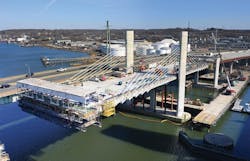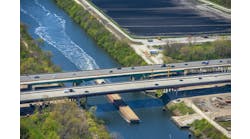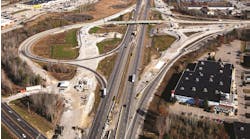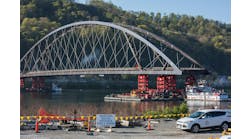Replacement of the “Q” Bridge, as it is known by New Haven, Conn., residents—so named for crossing the Quinnipiac River—is the sixth of seven parts to the I-95 New Haven Harbor Crossing (NHHC) Corridor Improvement Program, one of the largest multimodal transportation improvement initiatives in Connecticut history.
The project team is adding its own bit of history to the proceedings by making the new bridge the first extradosed bridge completed in the U.S., and the third in North America.
Several constraints made the innovative configuration a necessity. First and foremost, the new bridge had to connect with the flyover ramps to I-91; this suggested a cast-in-place segmental box girder design. New Haven Harbor, directly adjacent to the project site, threw a wrench into that plan.
“By the time you have a long-span bridge crossing the structure, the depth of the box girder wouldn’t permit the required navigational clearance,” project manager Sean Bush told Roads & Bridges.
The next thought was a traditional cable-stay bridge, featuring higher towers and lifting the whole structure. This was quickly overruled as well, due to FAA regulations surrounding nearby Tweed New Haven Regional Airport.
These conflicting requirements left little doubt that an extradosed approach was needed.
“They looked at a hybrid of the two, keeping a slender box across the river crossing for the navigational clearance and then keeping the towers short for aviation clearance,” Bush said.
At present, construction is in the second of three planned stages. Stage one built the new northbound bridge and shifted traffic over from the old bridge. In stage two, crews are building a temporary bridge to connect new with old and reroute southbound traffic. Stage three—expected to commence sometime next year—will create the new southbound bridge.
Upon completion, 10 lanes will be open to north- and southbound New Haven traffic. Accommodating that many lanes obviously requires a wide expanse; the main span, a cast-in-place segmental box girder, is 108 ft wide at its peak, narrowing to 98 ft.
“To my knowledge it’s one of the widest cast-in-place segmental boxes ever built,” Bush said.
Stage three will provide its own set of challenges, as the schedule is condensed for that portion. As a result, much of that work was done during stage one, consisting of trestle and foundation work beneath the existing southbound bridge.
“We focus on these towers and stay cables, which are impressive,” said Bush, “but a lot of impressive, challenging work is going on underneath the shadow of the existing bridge. R&B



